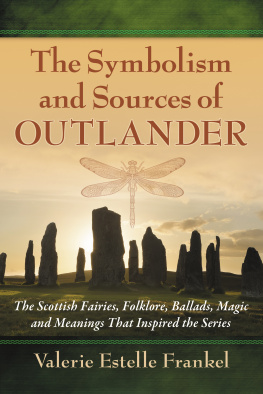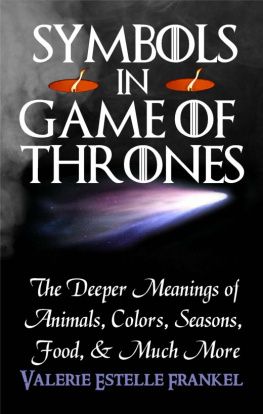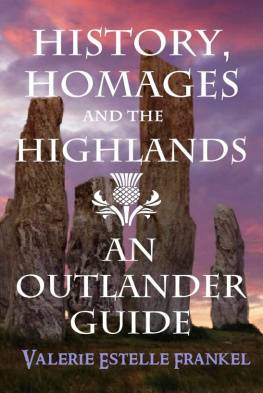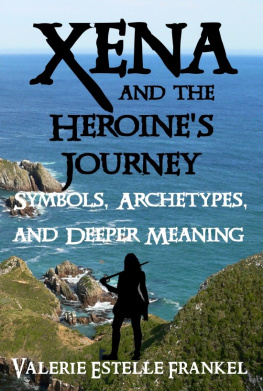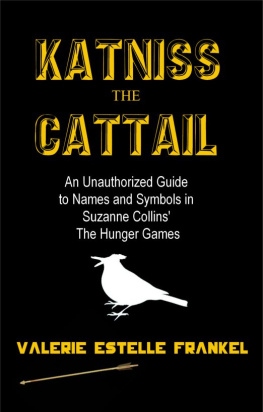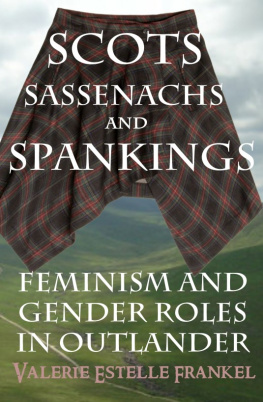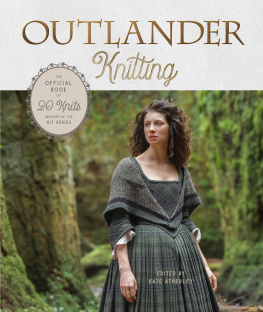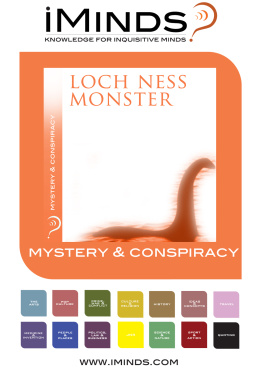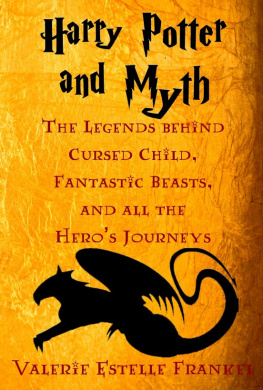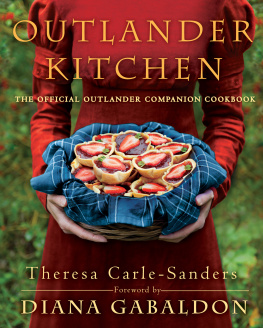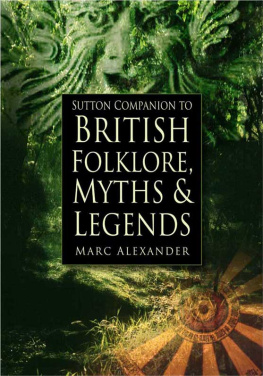
Also by VALERIE ESTELLE FRANKEL
Women in Game of Thrones: Power, Conformity and Resistance (2014)
Buffy and the Heroines Journey: Vampire Slayer as Feminine Chosen One (2012)
From Girl to Goddess: The Heroines Journey through Myth and Legend (2010)
EDITED BY VALERIE ESTELLE FRANKEL
The Comics of Joss Whedon: Critical Essays (2015)
Teaching with Harry Potter: Essays on Classroom Wizardry from Elementary School to College (2013)
FROM MCFARLAND
The Symbolism and Sources of Outlander
The Scottish Fairies, Folklore, Ballads, Magic and Meanings That Inspired the Series
Valerie Estelle Frankel

McFarland & Company, Inc., Publishers
Jefferson, North Carolina
LIBRARY OF CONGRESS CATALOGUING DATA ARE AVAILABLE
BRITISH LIBRARY CATALOGUING DATA ARE AVAILABLE
e-ISBN: 978-1-4766-2116-6
2015 Valerie Estelle Frankel. All rights reserved
No part of this book may be reproduced or transmitted in any form or by any means, electronic or mechanical, including photocopying or recording, or by any information storage and retrieval system, without permission in writing from the publisher.
McFarland & Company, Inc., Publishers
Box 611, Jefferson, North Carolina 28640
www.mcfarlandpub.com
Introduction
Outlander has finally reached television. Begun as a series of massive, eight-hundred-plus page novels (standing at eight books) complete with a spinoff series, short stories, guides and more, it has been entertaining many readers for decades. As well as offering romance and adventure, the series incorporates the myths of the ancient Celts into a world on the edge of rationalism. Claire Randall, a World War II nurse, brings her modern sensibility to the past, but even she is overwhelmed by a world of ghosts, monsters, and above all, the enchanted standing stones. Centuries before her own birth, her true love Jamie Fraser has seen the Wild Hunt and believes in the Fair Folk, even with his worldly upbringing. The ancient Sun Feasts and Fire Feasts open the standing stones, but unwary travelers may die inside them, rather than find enlightenment. Literature, myth, and symbolism permeate the series, connecting it with the history and culture of the period.
Workers sing folksongs, soldiers sing songs of the battlefield, travelers sing dirty ballads in the taverns. Funerals offer the Coronachloud praise songs of the deceasedwith the ban-treim, or professional mourner, wailing along. The television show of course is dominated by the Skye Boat song, memorializing Bonnie Prince Charlies frantic flight after losing his rebellion. Scottish instruments from the bodhrn and penny whistle to the Uilleann pipes and a variety of bagpipes dominate the score. Specific 1940s songs also accompany some scenes, emphasizing Claires perspective as she hears them even in the past. The first episode features Im Gonna Get Lit Up and Shuffle Rhythm on Franks car radio, with Run Rabbit Run as Claire flees British soldiers centuries before it was written.
Literature abounds, beginning with the Bible and the classics of Latin and Greek Jamie studied at university. Along with Shakespeare and well-known classics, he quotes from the poem The Hounds of Fingal about the culture hero Fionn Mac Cumhaill who sleeps under an Irish hill until hell be needed once more. Claire, by contrast, quotes English romantic poets she learned as a child. She sprinkles her references with the anachronisms of Robbie Burns and Sir Walter Scott, which nonetheless fit smoothly into the culture around her. Theres additional symbolism: the blue vase, strawberries and thistles, marvelous gowns of silver, white, or gold Claire is forced to wear. More prominent is jewelry: the pearl necklace or dragonfly in amber, wedding rings and betrothal bracelets, and the many perfect gems Geillis collects for her magic. Many precious stones bestowed for protection also bear traces of family lovegarnets from Rogers mother or the ruby of Jamies fathers ring.
Mythology and folklore touch every aspect of the adventure. In the modern age, standing stones transport Claire through time after she spies on an ancient Beltane dance. From there, small traces of magic continue to fill the world. Provocatively, Geillis asks a skeptical Claire, Have you never found yourself in a situation that has no earthly explanation? (Episode 103). The Loch Ness Monster appears to Claire after the men tell stories of a Scottish waterhorse around the fire, then Claire encounters a tiny changeling. In a more frightening moment, Claire is condemned as a witch and nearly killed by the mob, while Geillis more proudly claims this heritage for herself. Dougal takes her to a saints spring, while another one bubbles under the Abbey of Ste. Anne de Beaupre, both Celtic sacred places incorporated into Catholic life. Through this all, the prophecy of the Brahan Seer concerning the family of Fraser lingers, awaiting fulfillment.
In North America, wendigos and ghosts haunt the heroes, while Claire learns herbs and charms from the wisewoman Nayawenne. The West Indies offers a terrifying scene of zombies and Vodou ritual given power with blood and sacrifice. Lord John is haunted by a loa there, even as he tries to govern a myriad of mixing cultures. Meanwhile, the Chinese Yi Tien Cho instructs Claire in acupuncture and astrology, increasing her knowledge of other cultures mysticism.
Europe offers many old tales as the series continues: succubae, carved figurines and reliquaries, and the ever-present hauntings. Claire is called a White Lady in France, tied into legends of ghost women rising from their lakes to heal or kill. Master Raymond in Paris knows much of alchemy and astrology, the medicine (both New Age and ancient) of herbalism and auras. Scottish culture itself incorporates many European traditions: the Norse god Odin features in legends, as do Roman gods and genius loci. Witchcraft, spells, and the casting of runes are all Norse, while Claire often sees Jamie as a berserk Viking warrior from a century gone by. Though the show omits some of the magical references (like the Loch Ness Monster) it too performs a balancing act between the world of the present and that of the supernatural past.
While avoiding the dread spoilers to focus on symbols and myths in the Highlands (and beyond), its hard to ignore that at this time the book series is more than eight times longer than the show. Thus, while significant events are left vague, a small introduction to all the characters seems necessary. Season one/book one offers Claire, Jamie, and Frank in their love triangle, along with Jamies scheming uncles Colum and Dougal MacKenzie, Jamies faithful Fraser cousin Murtagh, and Jamies nemesis, Black Jack Randall. There are also Jamies dead parents Ellen and Brian Fraser and his living sister Jenny with her husband Ian Murray and their children. The conniving witch Geillis Duncan is significant, as is the Reverend Wakefield, a historian and Franks close friend back in the 1940s.
Main characters in the later books include the next generation: time-travelers Brianna and Roger and Jamies adopted children Young Ian, Fergus, and Marsali. Colum, Dougal, and Ellens sister Jocasta Cameron appear as well. Lord John Grey, an English soldier introduced in the second book and Jamies friend, has significant plot threads, as well as a spinoff series of his own.
Next page
